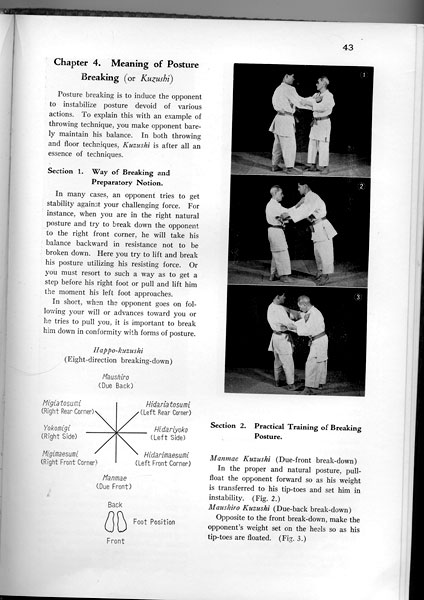
|
|
Over the years it has been accepted to translate the term "kuzushi" in English as "breaking balance." I think this is not only incorrect and misleading but has been one of the major problems in getting the real meaning of this important aspect of the practice of judo, aikido, and other traditional budo. I don't want to go into a detailed explanation of kuzushi here as it's not easy to do in this format. It will be done in my book but there'll be lots of photos and will be a major undertaking. I'll take many pages to describe and illustrate what Mifune and Tomiki did in a couple of paragraphs in their books. If you already understand what they're talking about, their limited words make sense, but if you don't, people just keep reading with no comprehension about the real meat of kuzushi. I don't believe their motivation was to keep it a "secret" or, as some have said, the Japanese didn't want gaijin to understand the secrets. Some zenophobic teachers may have felt that way or still do but not Mifune, and especially Tomiki, Miyake, and others that had the goods that I have felt and understood their hearts. I have put two pages here from the "Canon of Judo" by K. Mifune, Kodokan Judan. One from the original and the reprint and newly translated version of the same book. The differences in translation are huge in my opinion. The new translation shows a common view of kuzushi that is prevelant in the kyogi judo (sport) mentality and in the aikido world while the original translation, although hard to understand, has more valuable information that helps us understand true kuzushi. |

|
|

|
Notice in this new translation that the first sentence is much different than the first translation. "Kuzushi is the art of disrupting the opponent's balance so he is forced into a vulnerable position." Forcing someone into a vulnerable position is extremely difficult. Going further into the second sentence, "... to apply a throwing technique (nage waza), you must break the opponent's balance so that he cannot support his center of gravity. Compare this with the older translation of, "... you make the opponent barely maintain his balance." This may seem like a small difference, but it is a HUGE difference in tactical usage. This difference is the meat of real kuzushi. If we DISRUPT the opponent's balance so that they BARELY MAINTAIN THEIR BALANCE and try to recover because they want to keep attacking or get away... then we get to use the force they create in attempting this recovery. Also, because they are bipedal, it is not difficult to predict where they have decided to go in this recovery. We then apply the priniciples of kuzushi by fitting (the concurrent parts of tsukuri... jibun no tsukuri and aite no tsukuri... or fitting ourself and the opponent together appropriately without clashing. This is in effect the real definition of AIKI. When this happens then the kake or waza (technique) happens. |
| Notice above the photos that indicate lifting as opposed to dropping center. I have closely observed slow motion frame by frame video of many of the top judo and aikido teachers in the past and today. When in dynamic motion they never lift (unless they have "brainwashed" compliant uke. However, they often describe and demonstrate, during teaching, incorrect use of power. We must be able to understand kihon, riai, and waza so well that we can do them slowly or dynamically using the principles properly so that our action and words are congruent. |
| I welcome ongoing discussion and feedback about this subject. However, I would rather not have this shared with people that are interested in arguing or trying to defend the way they view this. I can demonstrate the reality of this and why it works. I am not interested in internet and philisophical confrontational discussions with people that are not interested in seeing, feeling, learning, and practicing something that's real. I am the first to say that the way I understand these principles and teach them is NOT THE ONLY WAY. - C. Clark |